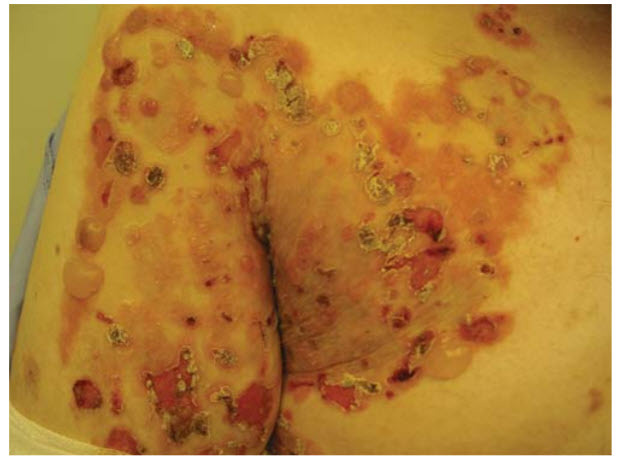Question 5#
A 57-year-old man presents with a blistering rash on his chest and upper arm (Figure below). He reports that the blisters often erupt and are mildly pruritic. He denies oral lesions. Nikolsky sign is negative. Biopsy is performed which reveals linear immunofluorescence of the epidermal basement membrane.

Which of the following is the underlying mechanism of this disease?
A. IgG antibodies against desmosomesB. Deposits of IgA at the tips of dermal papillae
C. Type IV hypersensitivity reaction following exposure to allergen
D. IgG antibodies against hemidesmosomes
Correct Answer is D
Comment:
IgG antibodies against hemidesmosomes. The patient in this question is presenting with signs and symptoms consistent with bullous pemphigoid. Given that Nikolsky sign (separation of the epidermis with lateral stroking of the skin) is negative and the biopsy demonstrated linear immunofluorescence of the epidermal basement membrane, bullous pemphigoid is more likely than pemphigus vulgaris. The underlying mechanism of this autoimmune disease involves IgG antibodies against hemidesmosomes (located on the epidermal basement membrane). Bullous pemphigoid often spares the oral mucosa and presents with tense blisters. (A) IgG antibodies against desmosomes is the mechanism underlying pemphigus vulgaris (PV), which has a higher mortality. Immunofluorescence studies in PV reveal antibodies around keratinocytes in a netlike pattern (intraepidermal separation rather than subepidermal separation associated with bullous pemphigoid). Furthermore, blisters tend to be flaccid in PV and Nikolsky sign is positive. (B) IgA deposition in the dermal papillae is the mechanism underlying dermatitis herpetiformis, which is associated with celiac disease. (C) A Type IV hypersensitivity reaction following exposure to an allergen is consistent with allergic contact dermatitis.